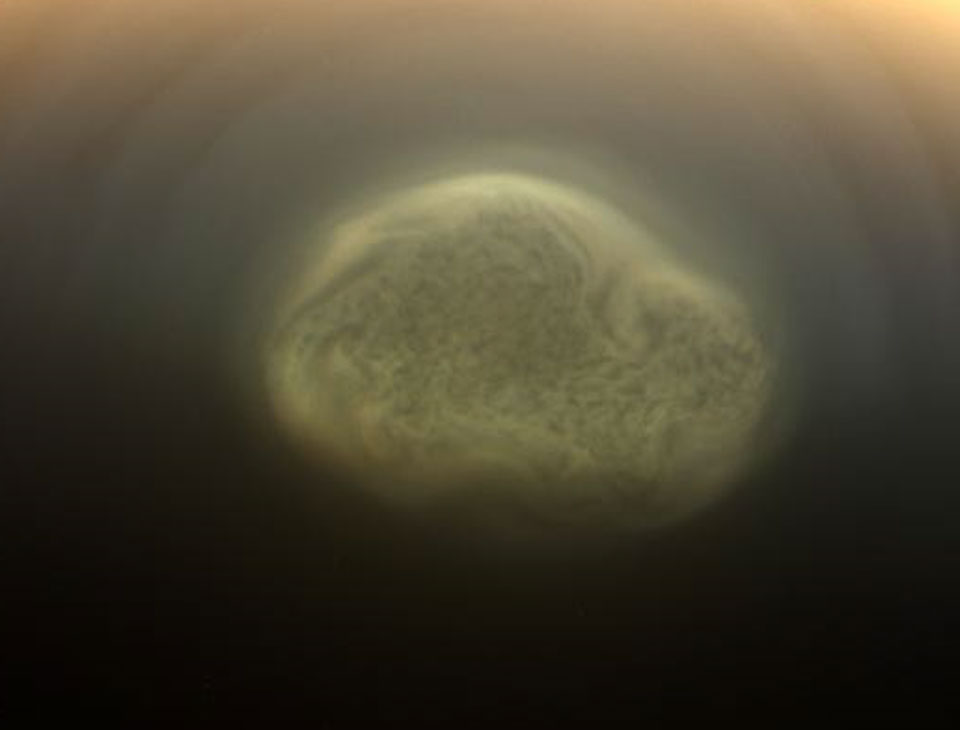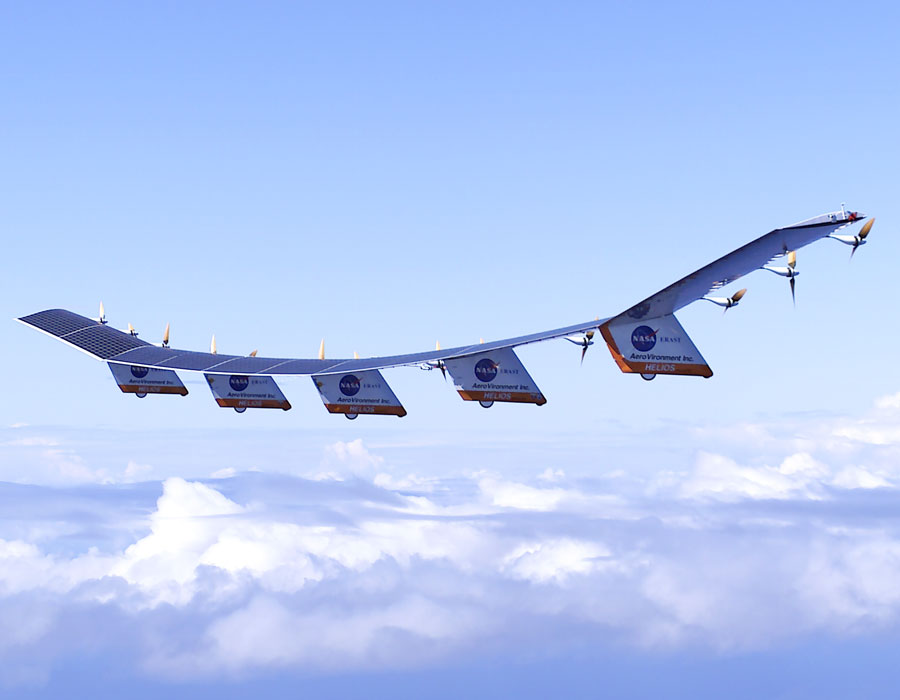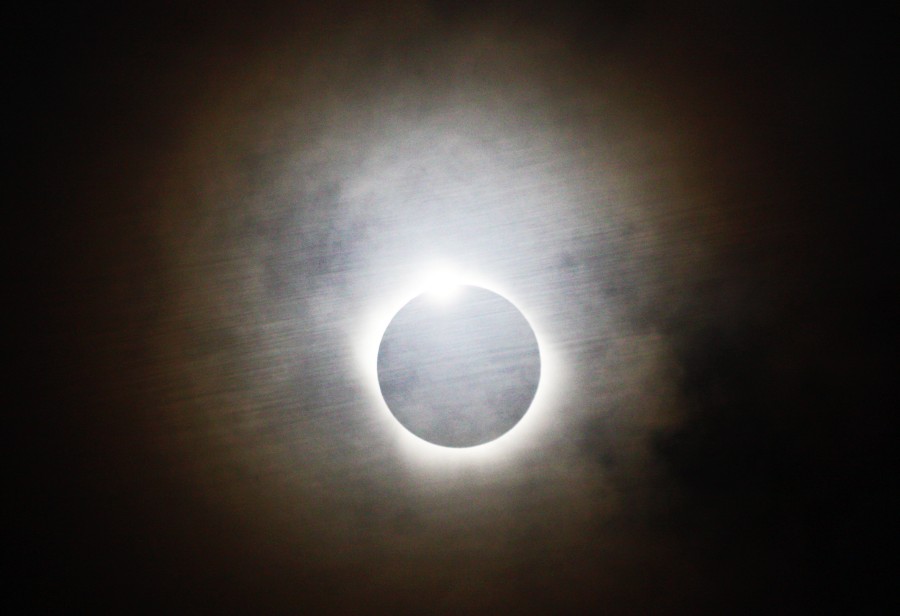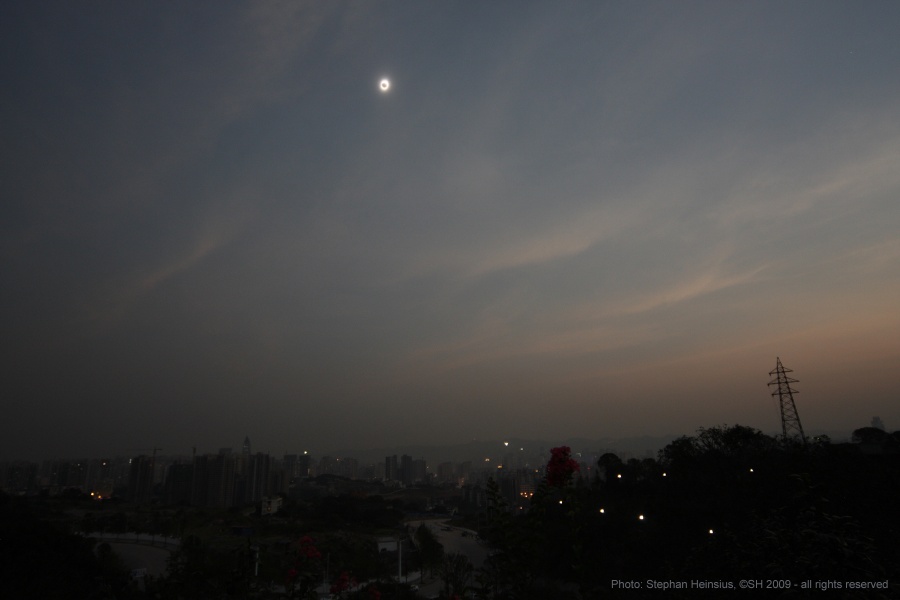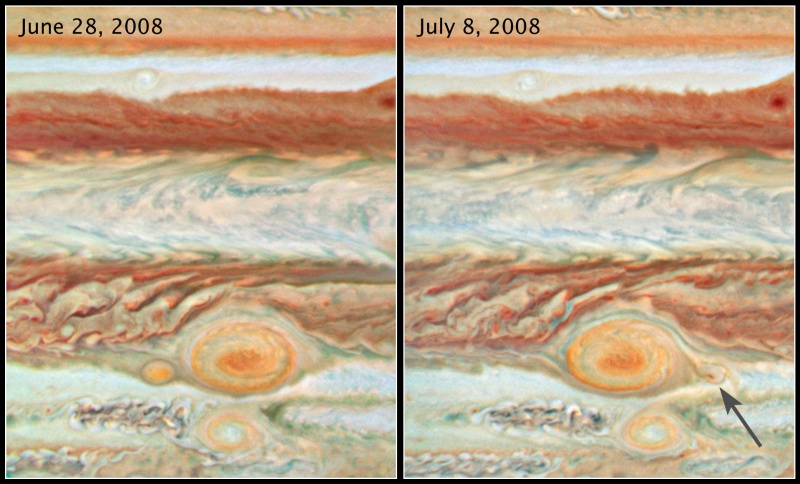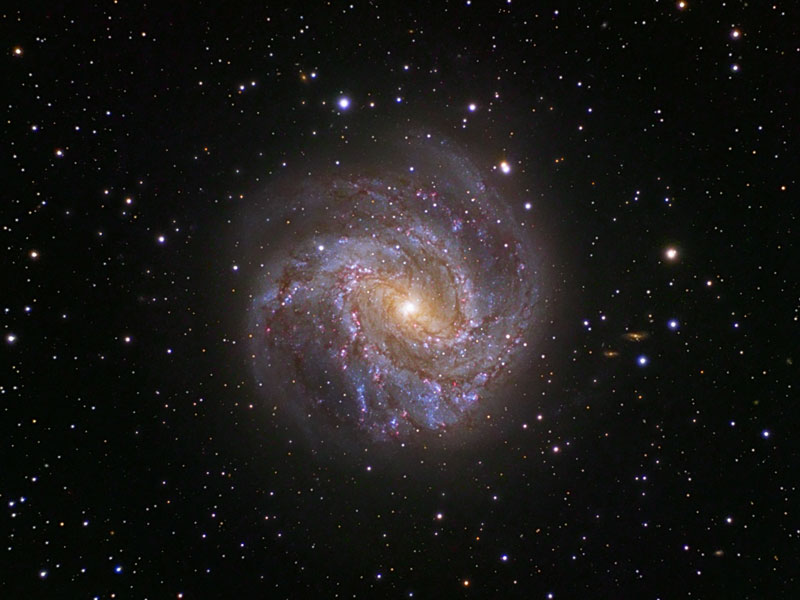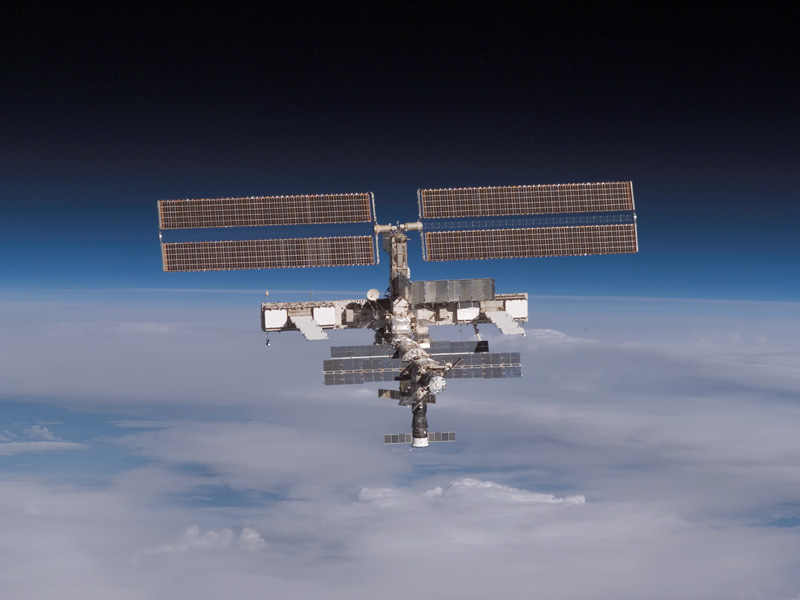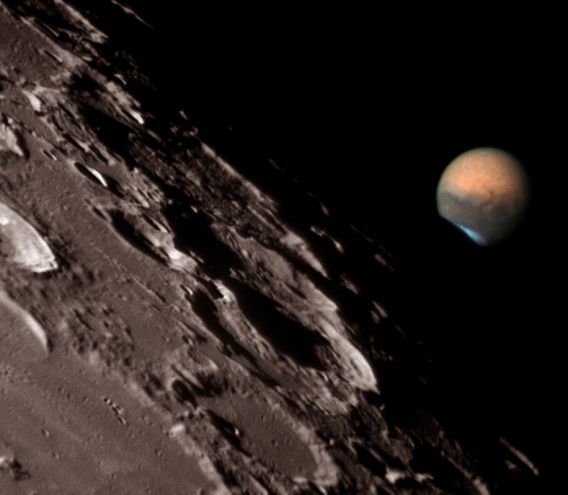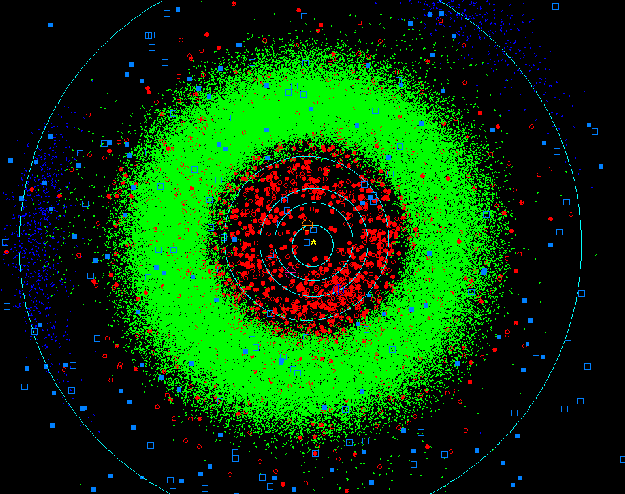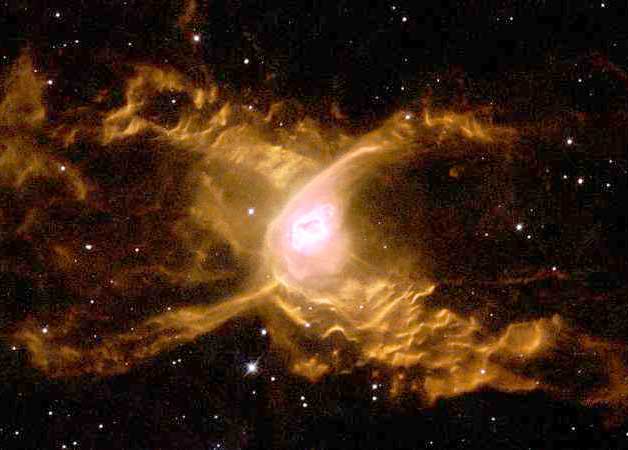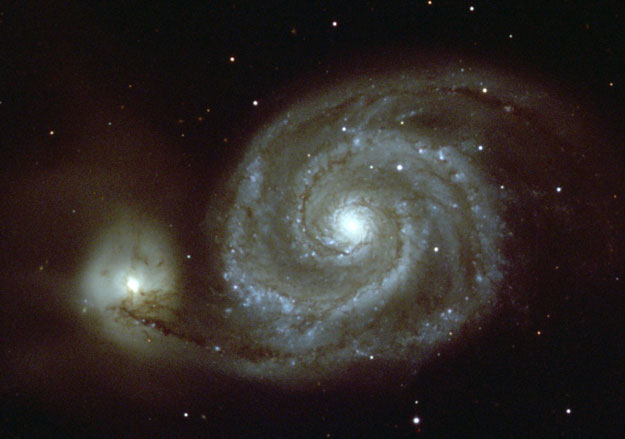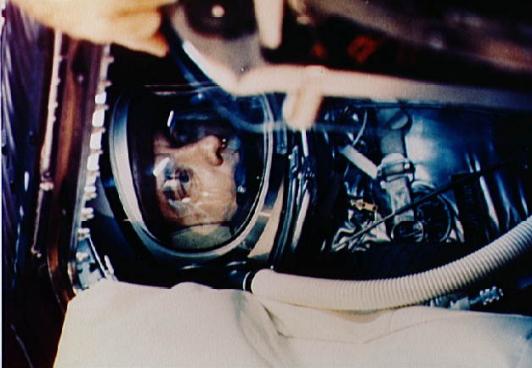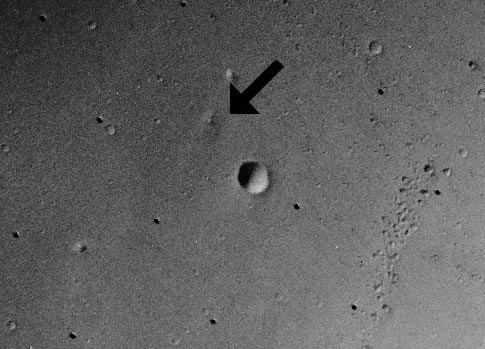| << Previous | Index | Next >> |
2015 A mere 2.5 million light-years away the Andromeda Galaxy, also known as M31, really is just next door as large galaxies go. So close and spanning some 260,000 light-years, it took 11 different image fields from the Galaxy Evolution Explorer (GALEX) satellite's telescope to produce this gorgeous portrait of the spiral galaxy in ultraviolet light. While its spiral arms stand out in visible light images of Andromeda, the arms look more like rings in the GALEX ultraviolet view, a view dominated by the energetic light from hot, young, massive stars. As sites of intense star formation, the rings have been interpreted as evidence Andromeda collided with its smaller neighboring elliptical galaxy M32 more than 200 million years ago. The large Andromeda galaxy and our own Milky Way are the most massive members of the local galaxy group.
2014 This alluring all-skyscape was taken 5,100 meters above sea level, from the Chajnantor Plateau in the Chilean Andes. Viewed through the site's rarefied atmosphere at about 50% sea level pressure, the gorgeous Milky Way stretches through the scene. Its cosmic rifts of dust, stars, and nebulae are joined by Venus, a brilliant morning star immersed in a strong band of predawn Zodiacal light. Still not completely dark even at this high altitude, the night sky's greenish cast is due to airglow emission from oxygen atoms. Around the horizon the dish antenna units of the Atacama Large Millimeter/submillimeter Array, ALMA, explore the universe at wavelengths over 1,000 times longer than visible light.
2013
Video Credit & Copyright: Ken Murphy (MurphLab); Music Ariel (Moby)
2012 What's happening over the south pole of Titan? A vortex of haze appears to be forming, although no one is sure why. The above natural-color image shows the light-colored feature. The vortex was found on images taken last month when the robotic Cassini spacecraft flew by the unusual atmosphere-shrouded moon of Saturn. Cassini was only able to see the southern vortex because its orbit around Saturn was recently boosted out of the plane where the rings and moons move. Clues as to what created the enigmatic feature are accumulating, including that Titan's air appears to be sinking in the center and rising around the edges. Winter, however, is slowly descending on the south of Titan, so that the vortex, if it survives, will be plunged into darkness over the next few years.
2011 An example of solar-powered flight, NASA's Helios aircraft flew almost one hundred years after the Wright brothers' historic flight on December 17, 1903. Pictured here at 3,000 meters in in skies northwest of Kauai, Hawaii, USA in August 2001, the remotely piloted Helios is traveling at about 40 kilometers per hour. Essentially an ultralight flying wing with 14 electric motors, the aircraft was built by AeroVironment Inc. Covered with solar cells, Helios' impressive 247 foot wide wing exceeded the wing span and even overall length of a Boeing 747 jet airliner. Climbing during daylight hours, the prototype aircraft ultimately reached an altitude just short of 30,000 meters, breaking records for non-rocket powered flight. Helios was intended as a technology demonstrator, but in the extremely thin air 30,000 meters above Earth's surface, the flight of Helios also approached conditions for winged flight in the atmosphere of Mars.
2010 As the total phase of July 11's solar eclipse came to an end, sunlight streaming past the edge of the Moon's silhouette created the fleeting appearance of a glistening diamond ring in the sky. Seen through a thin cloud layer from the French Polynesian atoll of Hao it also produced remarkable shadow bands, flickering across the dramatic sky. Projected onto the cloud layer, the shadow bands are parallel to the sliver of sunlight emerging from behind the Moon's edge. Caused by turbulence in Earth's atmosphere refracting the sliver of sunlight, the narrow bands were captured in this brief, 1/400th second exposure. Shining through the cloud droplets, the sunlight also produced a luminous atmospheric corona, not to be confused with the solar corona seen during eclipse totality. The atmospheric corona is centered on the bright diamond of emerging sunlight.
2009 The daytime sky grew dark, the temperature dropped, and lights came on as Chongqing, China, was plunged into the Moon's shadow during the July 22nd total solar eclipse. This serene, wide-angle view of the event looks to the east over the large, populous city from a newly constructed park. Despite thin clouds, it captures the shimmering solar corona just before the end of the eclipse total phase. This total solar eclipse occurred near Aphelion, the point in Earth's elliptical orbit farthest from the Sun, and so the Sun was near its smallest apparent size. It also occurred when the New Moon was near Perigee, the closest point to Earth in the Moon's elliptical orbit, making the Moon near its largest apparent size. The small Sun and large Moon made this the longest solar eclipse of this century.
2008
2007 M83 is one of the closest and brightest spiral galaxies on the sky. Visible with binoculars in the constellation of Hydra, majestic spiral arms have prompted its nickname as the Southern Pinwheel. Although discovered 250 years ago, only much later was it appreciated that M83 was not a nearby gas cloud, but a barred spiral galaxy much like our own Milky Way Galaxy. M83, pictured above, is a prominent member of a group of galaxies that includes Centaurus A and NGC 5253, all of which lie about 15 million light years distant. Several bright supernova explosions have been recorded in M83. An intriguing double circumnuclear ring has been discovered at the center of M83.
2006 This was home. Last week, the STS-121 crew of the Space Shuttle Discovery undocked from the International Space Station (ISS) and returned to Earth. As the shuttle departed the space station, they took the above image. Visible on the ISS are numerous modules, trusses, and long wing-like solar panels. The space shuttle crew spent over 12 days calling the space station home. The shuttle crew resupplied the space station and prepared it for future assembly. The ISS's crew of two was expanded to three by the shuttle visit, and now includes one Russian, one American, and one European.
2005 If you wait long enough, a piece of outer space itself will come right to you. As Colby Navarro worked innocently on the computer, a rock from space crashed through the roof, struck the printer, banged off the wall, and came to rest near the filing cabinet. This occurred around midnight on March 26, 2003 in Park Forest, Illinois, USA, near Chicago. The meteorite, measuring about 10 cm across, was one of several that fell near Chicago that day as part of a tremendous fireball. Pictured above is the resulting hole in the ceiling, while the inset image shows the wall dent and the meteorite itself. Although the vast majority of meteors is much smaller and burn up in the Earth's atmosphere, the average homeowner should expect to repair direct meteor damage every hundred million years.
2004 Comet Shoemaker-Levy 9, named after its co-discoverers, was often referred to as the "string of pearls" comet. It is famous for its suggestive appearance as well as its collision with the planet Jupiter! The comet's original single nucleus was torn to pieces by Jupiter's strong gravity during a close encounter with the solar system's largest planet in 1992. The pieces are seen (scroll right) in this composite of Hubble Space Telescope images to be "pearls" strung out along the comet's orbital path. Only ten years ago, in July of 1994, these pieces collided with Jupiter in a rare and spectacular series of events.
2003 What was that bright "star" near the Moon last week? Mars of course, as the Red Planet wandered near the waning gibbous Moon early last Thursday morning, passing behind the lunar orb when viewed from some locations in South and Central America, the Caribbean, and Florida. The Clay Center Observatory expedition to Bonita Springs, Florida produced this evocative picture of Mars grazing the Moon's dark edge by digitally stacking and processing a series of telescopic images of the event. With the cratered Moon in the foreground, the bright planet Mars seems alarmingly close, its global scale features and white south polar cap easily visible. Already impressive, the apparent size of the martian disk will continue to grow in the coming weeks, until, on August 27, Mars reaches its closest approach to planet Earth in over 50,000 years.
2002 Our Solar System is a busy place. Although the major planets get the most press, a swarm of rocks, comets, and asteroids also exist. The above plot shows the placement of known inner Solar System objects on 2002 July 20. The light blue lines indicate the orbits of planets. The green dots indicate asteroids, officially known as minor planets. The red dots indicate asteroids that come within 1.3 Earth-Sun distances (AU) of the Sun and so pose an increased (although small) collision risk with the Earth. Comets appear as dark blue squares, while dark blue points are Jupiter Trojans, asteroids that orbit just ahead of, or just behind Jupiter. Note that most asteroids of the inner Solar System orbit between Mars and Jupiter in the main asteroid belt. Every day this plot shifts with objects nearer the Sun typically shifting the most. The current locations of these objects can be found here.
2001 Oh what a tangled web a planetary nebula can weave. The Red Spider Planetary Nebula shows the complex structure that can result when a normal star ejects its outer gases and becomes a white dwarf star. Officially tagged NGC 6537, this two-lobed symmetric planetary nebula houses one of the hottest white dwarfs ever observed, probably as part of binary star system. Internal winds emanating from the central stars, visible in the center, have been measured in excess of 1000 kilometers per second. These winds expand the nebula, flow along the nebula's walls, and cause waves of hot gas and dust to collide. Atoms caught in these colliding shocks radiate light shown in the above representative-color picture. The Red Spider Nebula lies toward the constellation of Sagittarius. It's distance is not well known but estimated by some to be about 4000 light-years.
2000 The Whirlpool Galaxy is a classic spiral galaxy. At only 23 million light years distant and fully 65 thousand light years across, M51, also known as NGC 5194, is one of the brightest and most picturesque galaxies on the sky. The smaller galaxy appearing here below and to the left is well behind M51, as can be inferred by the dust in a foreground spiral arm blocking light from this smaller galaxy. The Whirlpool, pictured above, is visible with binoculars in the constellation of Canes Venaciti. M51 is a spiral galaxy of type Sc and is the dominant member of a whole group of galaxies. Astronomers speculate that M51's spiral structure is primarily due to its gravitational interaction with this smaller galaxy.
1999 This delightfully detailed false color image of Saturn was earmarked to celebrate the 8th anniversary of the orbiting Hubble Space Telescope. The picture is a combination of three images taken in January 1998 and shows the lovely ringed planet in reflected infrared light. Different colors indicated varying heights and compositions of cloud layers generally thought to consist of ammonia ice crystals. The eye-catching rings cast a shadow on Saturn's upper hemisphere, while the bright stripe seen within the left portion of the shadow is infrared sunlight streaming through the large gap in the rings known as the Cassini Division. Two of Saturn's many moons have also put in an appearance, Tethys just beyond the planet's disk at the upper right, and Dione at the lower left.
1998 On another Friday (May 5, 1961), at the dawn of the space age, NASA controllers "lit the candle" and sent Alan B. Shepard Jr. arcing into space atop a Redstone rocket. The picture shows the pressure-suited Shepard before the launch in his cramped space capsule dubbed "Freedom 7" . This historic flight - the first spaceflight by an American - made Shepard a national hero. Born in East Derry, New Hampshire on November 18, 1923, Shepard graduated from the United States Naval Academy in 1944 and went on to train and serve as a Naval Aviator. Chosen as one of the original seven Mercury Program astronauts, he considered this first flight the greatest challenge and actively sought the assignment. Shepard's accomplishments in his career as an astronaut spanned a remarkable period in human achievement and in 1972 he walked on the moon as commander of the Apollo 14 mission. A true pioneer and intrepid explorer, Alan Shepard died Tuesday at age 74 after a lengthy illness.
1997 Where is Mars Pathfinder? Follow the arrow in the above picture taken by the Viking Orbiter in 1976. From the surface Mars appears covered with rocks, but from orbit Mars appears covered with craters. However, several familiar features are visible in this photograph. To the left (west) of Sagan Memorial Station are the now-familiar twin peaks that dominate the horizon of many Pathfinder photographs. These hills are about one kilometer from the landing site, twice the planned range of Sojourner. Two craters loom nearby: a small one to the east not easily visible here, and a big one to the south of Pathfinder. The landing site is in the dry flood channel named Ares Vallis.
1996 Diffuse gas clouds laced with radioactive aluminum atoms (Al26) line the plane of our Milky Way Galaxy! How do we see them? Relying on the Compton Effect, the COMPTEL instrument onboard NASA's immense orbiting Compton Gamma Ray Observatory can "see" the 1.8 million electron Volt gamma rays emitted by the radioactive decay. COMPTEL's first ever survey image of the entire sky in the light of gamma rays produced by this exotic radioactivity is shown above. The Galactic plane is horizontal, passing through the Galactic center in the middle of the picture, as indicated by the superposed coordinate grid. The radioactive Al26 clouds are seen to lie in clumps near the plane, with some slightly above and below it. The brightest feature looks like a mysterious inverted "V", just to the left of center. Where do they come from? Al26 decays to magnesium (Mg26) with a half-life of about a million years, a very short time compared to the age of the Galaxy -- so the clouds must have been produced relatively "recently". COMPTEL astronomers are exploring several origins for the radioactive clouds including nuclear processing (nucleosynthesis) by aging massive stars and supernova explosions. Because they are generally thought to be associated with short lived massive stars, the radioactive clouds are expected to be located near sites of recent star formation. (Note added in press: Don't worry - the aluminum atoms in the foil in your kitchen are Al27 and are not radioactive!)
1995 Andromeda is the nearest major galaxy to our own Milky Way Galaxy. Our Galaxy is thought to look much like Andromeda. Together these two galaxies dominate the Local Group of galaxies. The diffuse light from Andromeda is caused by the hundreds of billions of stars that compose it. The several distinct stars that surround Andromeda's image are actually stars in our Galaxy that are well in front of the background object. Andromeda is frequently referred to as M31 since it is the 31st object on Messier's list of diffuse sky objects. M31 is so distant it takes about 2 million years for light to reach us from there.
| << Previous | Index | Next >> |


